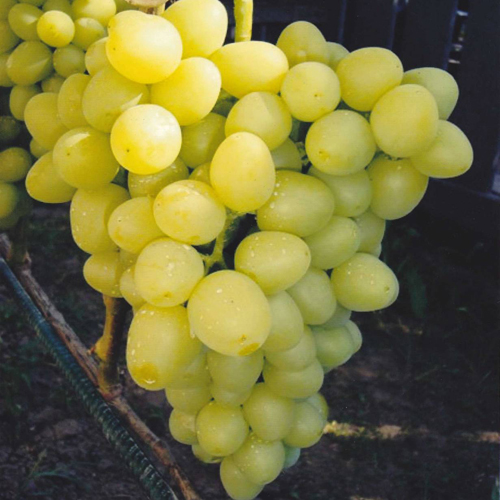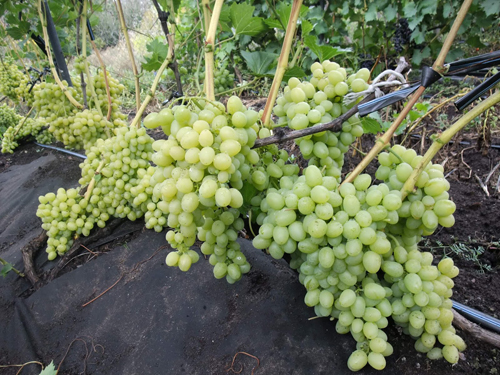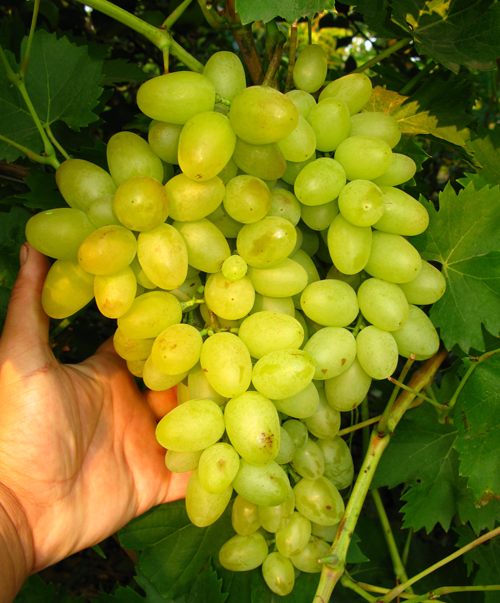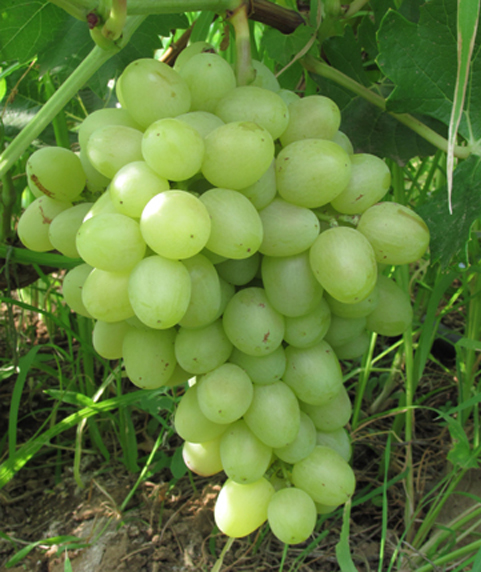Arcadia grape variety
Arcadia is a very popular and widespread table variety, bred at the Institute of Viticulture and Winemaking. V.E. Tairov, located in the Odessa region of Ukraine. Its authors were Dokuchaeva E.N., Meleshko L.F., Chabanenko E.P., Tarakhtiy L.I. Thanks to this team of scientists, our heroine was born as a result of crossing two varieties - Moldova and Cardinal, each of which has remarkable properties in itself. Moreover, the bunches of the grapes obtained were unexpectedly light-colored, although both parents had a dark berry. By the way, this parental pair was used in breeding and some other hybrid forms, but it was Arcadia that turned out to be the most successful of them. It is distinguished by early maturity, large-fruited, high yield and excellent taste. For this, fans appreciate her.

Our heroine is widespread everywhere. Officially included in the state register of plant varieties of Ukraine. In Russia, it is included in the State Register of Breeding Achievements in the North Caucasus Region (Republics of North Ossetia-Alania, Ingushetia, Adygea, Dagestan, Kabardino-Balkaria, Crimea, Chechen, Krasnodar and Stavropol Territories, Rostov Region). This grape is successfully grown by amateurs in the middle zone of the country, and even in greenhouse culture in the north.
Agrobiological characteristics
The growth force of the bushes of Arcadia is above average. The leaf is wide, light green, formed in the form of five lobes. The upper lateral notches are open slit-like, the lower ones are barely outlined. The petiole notch is closed with a narrow elliptical lumen. The denticles are large, triangular, with a wide base. The underside of the leaf blade has a slight bristly pubescence. The flower is bisexual. The grapes do not need additional pollination.

The bunches of the variety are large (with an average weight of 500-700 grams) and very large (up to two kilograms), cylindrical or winged of moderate density. The berries are not squeezed in the brush. The comb is medium, the stems of the berries are short and strong. The berries are large or very large - 23 × 28 mm, weighing up to 15 grams, egg-shaped. Color, depending on the degree of ripeness of the berries, from greenish to yellow with a very slight pink tint. The pulp of Arcadia is juicy-fleshy with a light unobtrusive harmonious taste, moderately sweet with a slightly tingling sourness. The skin is of medium thickness, firm but edible, covered with a white waxy coating. The bones are present, but small and in small quantities, as a rule, no more than two. The grape harvest can continue to hang from the bush even after it has reached removable maturity. After full ripening, the berries acquire light nutmeg tones in taste and aroma. The main thing is that there should be no sudden changes in moisture in the soil, in this case the berry may crack. Therefore, if the year was dry, it is better not to tempt fate and not overexpose the ripe crop on the bushes.
The collected bunches are used mainly for fresh consumption. This famous and easily recognizable variety is highly appreciated by consumers. Its presentation and transportability are invariably high. It is for this that Arcadia is loved and widely grown by winegrowers for commercial purposes.

The grapes are early ripening, with the duration of the growing season from budding to the ripening of bunches 115−125 days. The sum of active temperatures during this time should be at least 2400-2600 ° С. This makes it possible to grow this variety outdoors even in the middle lane without using means to artificially increase the amount of active temperatures, while in more northern regions it will not be possible to do without a greenhouse. The yield is very high (more than 110 c / ha), in connection with which the variety is even called "suicide", because it can tie many more brushes than it is able to "stretch" without harming itself.The overload of the bushes with the harvest affects the growing season (they are significantly lengthened), the quality of the fruits (it is difficult for the plant to gain the necessary sugar content) and the degree of ripeness of the shoots, which significantly reduces the chances of the vine to successfully overwinter. In general, with the right load, up to 20 kilograms of berries can be harvested from the bush, while the ripening of the shoots will be good. Dissolving buds 65%. Fruitful shoots - 60-70%. On one fruitful shoot, an average of up to one and a half bunches are laid. Arcadia is characterized by a moderate sugar content of the juice of berries - about 15-16 g / 100 cm³, which is imperceptible against the background of also low acidity - 4-6 g / l. Thus, this grape can be called dietary. On a hot summer day, the juicy bunch of this variety refreshes rather than satiates.

Agrotechnical features
Despite the immense popularity, our heroine has both positive and negative sides when growing. The former can definitely include excellent rooting of cuttings and good adhesion with common rootstocks, a powerful root system, good growth vigor of bushes and early fruiting, increased resistance to mildew, and no tendency to pea berries. Wasps grapes are slightly damaged due to a fairly dense skin. Of the shortcomings, there is a lack of protection against the root phylloxera, which is why cultivation in a root-own culture is possible only outside areas of continuous infection with this pest, a tendency to overloading the crop, which is dangerous for the plant itself, and susceptibility to powdery mildew. Frost resistance of Arcadia is at an average level - up to -21 ° С.
The combination of these properties determines the strategy of the grower 's approach to this variety. In particular, responsible and high-quality rationing of the load, thinning of shoots and bunches on them is vitally necessary for him. The optimal load when pruning grapes in spring is 35-45 eyes. The length of pruning of fruit arrows can be either long or short, the main thing is not to exceed the total value of the optimal load on the bush. The estimated number of fruitful shoots should not exceed 8 pieces per 1 square meter of the feeding area of the bush. Excess shoots must be removed during green debris in the early stages of the growing season. On the remaining vines, it is necessary to keep only one strongest bunch, no matter how sorry it is to remove the rest.
The form of conducting the Arcadia bush must be chosen taking into account climatic conditions and not the most outstanding frost resistance of grapes. The best will be a fan formation of several sleeves, covered for the winter. Only in the very south will cultivation on a trunk be justified, but even there it will not be superfluous to form a lightweight lower tier, sheltered for the winter.
The variety responds well to the introduction of moderate doses of fertilizers into the soil, and especially to the regulation of the water regime of the soil. Watering, which protects plants from excessive drought in summer, will not only help to increase the size and increase the juiciness of the berries, but also prevent them from cracking, which grapes are prone to due to changes in soil moisture. As a result, it will be possible to keep clusters on the bush for a long time without risk in order to achieve excellent organoleptic characteristics.
Protection of Arcadia from powdery mildew should be carried out in full according to standard schemes, from mildew enough preventive treatment.
Summing up, it is worth noting that this variety is not one of the extremely unpretentious, it requires attention and a competent approach, but the result of its cultivation cannot but rejoice. Early ripening, beautiful in size, shape, color, taste and aroma, the bunches do not leave anyone indifferent, bringing the winegrower genuine satisfaction from the work expended.








